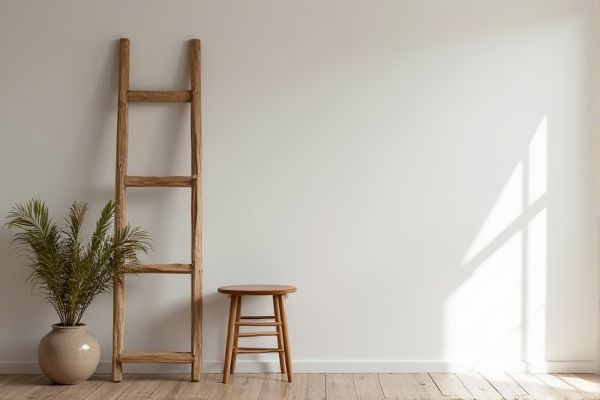
A decorative ladder offers versatile, stylish storage and display options for your home, while a step stool provides practical height assistance for reaching elevated objects safely. Explore the rest of the article to discover which option best suits your needs and enhances your living space.
Table of Comparison
| Feature | Decorative Ladder | Step Stool |
|---|---|---|
| Primary Use | Home decor, hanging blankets, towels | Reaching higher shelves, seating |
| Material | Wood, metal, bamboo | Wood, plastic, metal |
| Portability | Lightweight, easy to move | Compact, foldable options available |
| Weight Capacity | Low - not for climbing | High - designed for climbing |
| Height | Taller, up to 6 feet | Shorter, up to 2 feet |
| Design | Stylish, aesthetic-focused | Functional, safety-focused |
| Safety Features | Minimal | Non-slip feet, sturdy steps |
| Cost | Moderate to high | Low to moderate |
Introduction to Decorative Ladders and Step Stools
Decorative ladders offer versatile design elements for home organization and display, combining aesthetics with functionality in living rooms, bedrooms, or bathrooms. Step stools provide practical height assistance for reaching elevated areas, constructed from sturdy materials to ensure safety and portability. Choosing between decorative ladders and step stools depends on balancing visual appeal with usability for specific household needs.
Design and Aesthetic Appeal
Decorative ladders feature sleek, minimalist designs with natural wood finishes or metal frames, making them versatile accents in modern, rustic, or industrial interiors. Step stools prioritize functional design with sturdy, compact shapes and often incorporate foldable or non-slip features while still offering customizable styles to blend with home decor. Both options enhance aesthetic appeal by balancing practicality with visual interest, elevating room ambiance without sacrificing utility.
Functionality and Practical Uses
Decorative ladders primarily serve as stylish storage solutions for blankets, towels, or magazines, enhancing home decor while offering limited climbing capability. Step stools provide essential functionality by offering stable, compact elevation for reaching high shelves, changing light bulbs, or performing household tasks safely. While decorative ladders emphasize aesthetic appeal and light utility, step stools prioritize safety, portability, and practical access to elevated areas.
Space-Saving Solutions
Decorative ladders offer a stylish, vertical storage option that uses wall space efficiently, making them ideal for small rooms or apartments. Step stools provide functional elevation for reaching high places but require floor space, which can limit their usefulness in tight areas. Your choice depends on balancing aesthetic appeal with practical space-saving needs.
Material and Build Quality
Decorative ladders typically feature lightweight wood or metal materials designed for aesthetic appeal and moderate durability, making them ideal for holding blankets or lightweight items. Step stools prioritize sturdier construction with reinforced joints and non-slip surfaces, often using heavy-duty wood, steel, or durable plastic to support greater weight and ensure safety during use. Choosing your option depends on whether you need functional strength for climbing or a stylish accent to complement your decor.
Safety and Stability Considerations
Decorative ladders primarily serve aesthetic purposes and may lack the robust construction and non-slip features needed for frequent climbing, posing safety risks compared to step stools designed with stability in mind. Step stools typically include wide, textured steps and sturdy bases to prevent tipping and ensure user security during tasks at elevated heights. Selecting equipment with certified weight limits, anti-slip surfaces, and secure footing is essential to minimize accidents and enhance user confidence during use.
Versatility in Home Decor
Decorative ladders offer a unique blend of functionality and aesthetic appeal, easily enhancing your living space by serving as stylish storage for blankets, plants, or towels. Step stools provide practical utility for reaching high shelves but generally lack the visual impact that decorative ladders bring to home decor. Choosing between the two depends on whether your priority is versatility in design or straightforward practicality.
Price Comparison and Value
Decorative ladders typically cost between $30 and $150, offering an affordable and stylish storage solution for blankets or towels, while step stools range from $20 to $100 but provide practical functionality for reaching high places. Your choice depends on whether you prioritize aesthetic value or utility, as decorative ladders add visual appeal with moderate price points, whereas step stools maximize functionality at a slightly lower cost. Both options deliver strong value, but a step stool generally offers better investment for frequent use and stability.
Maintenance and Durability
Decorative ladders, typically made from wood or lightweight metals, require regular dusting and occasional sealing or varnishing to maintain their aesthetic appeal and prevent wear from moisture or scratches. Step stools, often constructed with sturdier materials like reinforced plastic or steel, offer greater durability and resistance to heavy loads, making them less prone to damage over time. Proper maintenance of both involves inspecting joints and surfaces for damage, but step stools generally need less frequent upkeep compared to decorative ladders exposed to environmental factors.
Choosing the Right Option for Your Space
Decorative ladders provide an aesthetic storage solution ideal for small spaces and adding rustic charm, while step stools prioritize functionality and safety for reaching higher places. Your choice depends on whether you value design and display or practical access and stability. Consider the available space and primary use to ensure the option enhances both your room's style and functionality.
 homyna.com
homyna.com